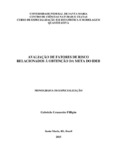| dc.contributor.advisor | Jacobi, Luciane Flores | |
| dc.creator | Fillipin, Gabriela Granzotto | |
| dc.date.accessioned | 2020-01-02T15:57:45Z | |
| dc.date.available | 2020-01-02T15:57:45Z | |
| dc.date.issued | 2015-07-17 | |
| dc.date.submitted | 2015 | |
| dc.identifier.uri | http://repositorio.ufsm.br/handle/1/19258 | |
| dc.description | Monografia (especialização) - Universidade Federal de Santa Maria, Centro de Ciências Naturais e Exatas, Curso de Especialização em Estatística e Modelagem Quantitativa, RS, 2015. | por |
| dc.description.abstract | The objective of this study is to identify what factors influence the poor academic performance and are reflected in the scores of the Basic Education Development Index (IDEB). Data were collected from municipal, state and federal schools from the elementary school system, a total of 62 schools in Santa Maria, from 2011 to 2013, available in the Qedu website. Explanatory variables were used, such as location of schools, number of employees, number of students enrolled, number of students who failed, the existence of a library, reading room, computer lab and science lab, sports court, cafeteria and accessibility. For the analysis the data, a multiple logistic regression model was used. The dependent variable for the model was whether school had or had not reached the target set for IDEB that year. As the IDEB elementary school is evaluated in two stages, initial years (5th year) and final years (9th year), a total of two models was obtained. The results of the model adjustment indicate that the significant predictors (p ≤ 0.05) for the 5th year of 2011 were the number of students who failed (OR = 1.063) and reading room (OR = 8,286), while in 2013 the included variables were science laboratory (OR = 0.159) and number of students who failed (OR = 1.079). For the 9th year, the model adjustment did not show any significant variable neither in 2011 nor in 2013, therefore not generating a model. As for the year 2013, the only variable included was the number of students who failed (OR = 1.079). The variable number of failures, which was present in all the adjusted models, stands out due to its negative contribution, because the higher its value, the smaller the chance of attaining the IDEB target. Thus, since it significantly influences the achievement of the target, this variable should receive more attention. With this study, some of the variables that significantly influence the results of IDEB scores can be identified, which can be used as an aid to schools for decision making and planning of public policies to improve education and raise the quality score. | eng |
| dc.language | por | por |
| dc.publisher | Universidade Federal de Santa Maria | por |
| dc.rights | Acesso Aberto | por |
| dc.rights | Attribution-NonCommercial-NoDerivatives 4.0 International | * |
| dc.rights.uri | http://creativecommons.org/licenses/by-nc-nd/4.0/ | * |
| dc.subject | IDEB (Índice de Desenvolvimento da Educação Básica) | por |
| dc.subject | Regressão logística | por |
| dc.subject | Odds ratio | por |
| dc.subject | Qualidade na educação | por |
| dc.subject | Logistic regression | eng |
| dc.subject | Quality in education | eng |
| dc.title | Avaliação de fatores de risco relacionados à obtenção da meta do IDEB | por |
| dc.title.alternative | Evaluation of risk factors related to the attainment of the ideb target | eng |
| dc.type | Trabalho de Conclusão de Curso de Especialização | por |
| dc.degree.local | Santa Maria, RS, Brasil | por |
| dc.degree.specialization | Estatística e Modelagem Quantitativa | por |
| dc.description.resumo | O objetivo deste estudo é identificar quais os fatores que influenciam no baixo rendimento escolar e são refletidos nas notas do Índice de Desenvolvimento da Educação Básica (IDEB). Foram coletados dados das escolas municipais, estaduais e federais, num total de 62 escolas da cidade de Santa Maria, de 2011 e 2013, do sistema de ensino fundamental, disponibilizados no site Qedu. Fez-se uso de variáveis explicativas como localização das escolas, número de funcionários, número de alunos matriculados, número de alunos reprovados, a existência de biblioteca, sala de leitura, laboratório de informática e de ciências, quadra de esportes, refeitório e acessibilidade. Para a análise dos respectivos dados, foi utilizado um modelo de regressão logística múltiplo. A variável dependente para o modelo foi se a escola tinha ou não atingido a meta estabelecida para o IDEB naquele ano. Como o IDEB do ensino fundamental é avaliado em duas etapas: anos iniciais (5º ano) e anos finais (9º ano), obteve-se um total de dois modelos. Os resultados do ajuste do modelo indicam que os preditos significativos ( 𝑝≤0,05) para o 5º ano de 2011 foram o número de alunos reprovados (OR = 1,063) e sala de leitura (OR = 8,286), enquanto que em 2013 as variáveis inclusas foram laboratório de ciências (OR = 0,159) e número de alunos reprovados (OR = 1,079). Para o 9º ano, o ajuste do modelo não apresentou nenhuma variável significativa no ano de 2011 e também de 2013, não gerando portanto um modelo. Destaca-se a variável número de reprovações que se fez presente em todos os modelos ajustados, sendo que sua contribuição é de forma negativa, pois quanto maior o seu valor, menor a chance de se atingir a meta do IDEB. Logo, já que ela contribui significativamente para o alcance da meta, deve-se ter maior atenção com esta variável. Com este estudo, pode-se identificar algumas das variáveis que influenciam significativamente no resultado das notas do IDEB, podendo usar estes resultados como auxilio às escolas para a tomada de decisões e para o planejamento das políticas públicas a fim de melhorar a educação e elevar o índice de qualidade. | por |
| dc.publisher.country | Brasil | por |
| dc.publisher.initials | UFSM | por |
| dc.subject.cnpq | CNPQ::CIENCIAS EXATAS E DA TERRA::PROBABILIDADE E ESTATISTICA | por |
| dc.publisher.unidade | Centro de Ciências Naturais e Exatas | por |



